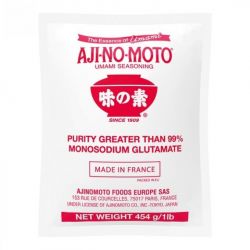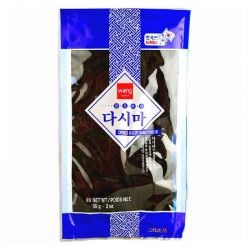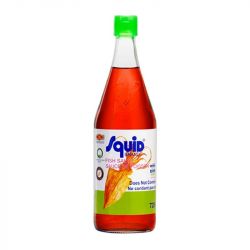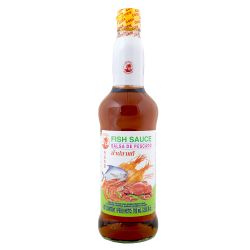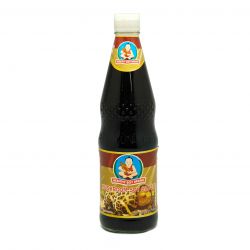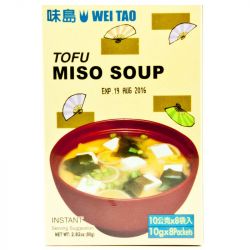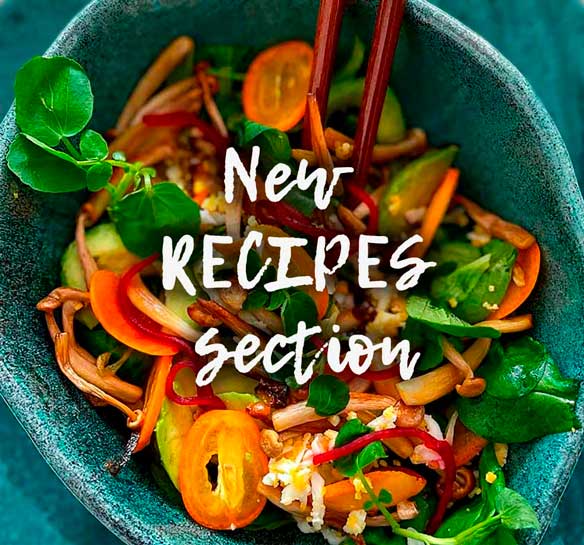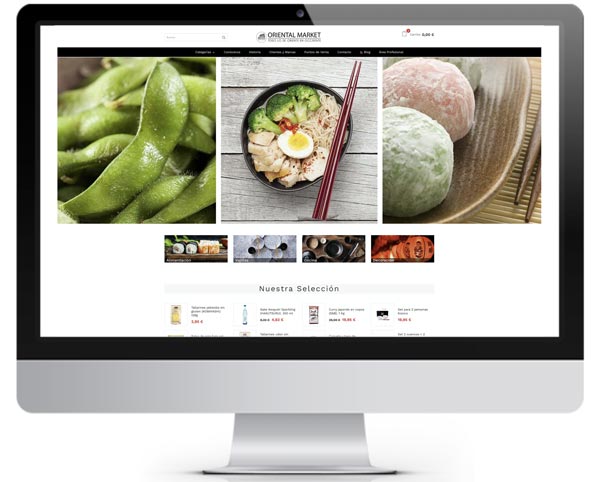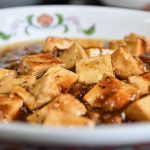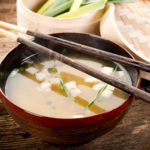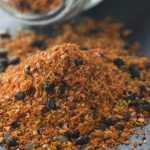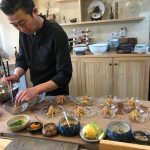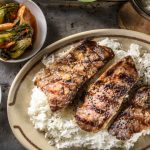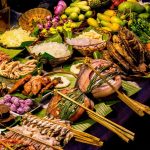Panko: what it is, how to use it and where to buy it
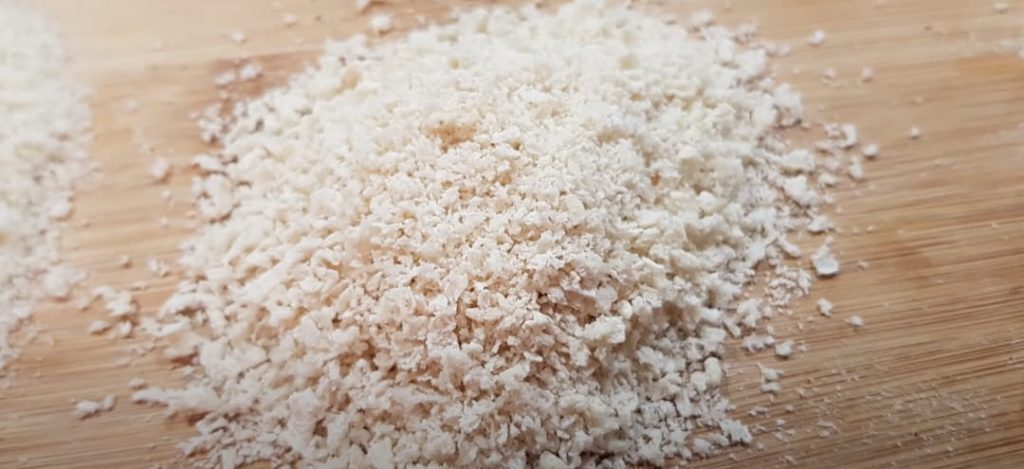
Surely many of you have used it during the preparation of one of your recipes, or it has simply been one of the star ingredients in one of the dishes that you have enjoyed one day in that oriental restaurant that you like so much. In one way or another, Japanese breadcrumbs or Panko is one of the most widely used ingredients in Asian cuisine for the preparation of such well-known recipes as prawn tempura.
What is panko?
Its name makes it clear. Because Panko means breadcrumb and that is precisely what it is, dry breadcrumbs that are transformed into flakes or dry flakes and that serve as a substitute for western breadcrumbs in oriental cuisine, it is Japanese breadcrumbs. A breadcrumb that is used both for gratin, breading or dusting in order to achieve a crunchy and light result. At Oriental Market you can find Panko in 1kg format. An essential ingredient that consists of wheat flour, yeast and salt.
What is special about panko is that it is much lighter than our breadcrumbs, as very soft white bread is used to make it, not the bread we use.
At first glance panko is much more crumbly than our breadcrumbs and is very white and is used for all fried dishes in Japan, giving them a very special texture and flavour; if you hold it in your hand you will notice that the consistency is similar to that of crushed breakfast flakes and this gives Japanese-style fried dishes their characteristic golden brown and crunchiness.
Buy panko online or in shops
You can buy panko in some of our shops in Barcelona and Madrid or in our online shop.
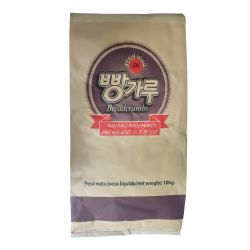
Panko rallado (SK) SACO/10kg
48,17 €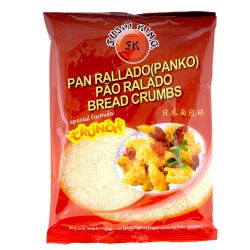
Pan rallado Japones Panko (SUSHI KING) 200g
1,70 €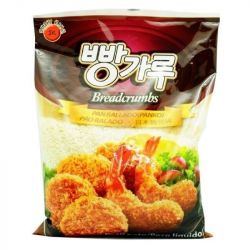
Pan Rallado Japonés "Panko" (SUSHI KING). 1kg
5,28 €
How is panko used in the kitchen?
Japanese breadcrumbs are used in fish, seafood, meat and vegetable recipes, providing a crunch effect that is not heavy. Easy to use, panko is an ideal ingredient for breading recipes, giving a different texture and flavour to your dishes.
This crunchiness is due to the fact that panko is not fried like classic breadcrumbs, but “swells” and incorporates air, which drains the frying fat and prevents the vegetables, meat and fish from getting soaked in oil.
This means that vegetables, meat and fish are not soaked in oil. On the other hand, as this particular breadcrumb comes in the form of rather large flakes rather than fine powder, it sticks more firmly to the food and so the taste also wins: try frying prawns or pork cutlets (tonkatsu) in panko, as the Japanese do, and you’ll never do it any other way again.
Recipes with panko bread
Recipe for crispy homemade sushi (with panko)
Ingredients for 3 rolls:
400 cc sushi rice
3 seaweed
Paprika
Cooked chicken breast
Ciboullette
Kanikama or crab or surimi sticks
Chives
Panko
2 eggs
A little flour
Rice vinegar
Sugar
Salt
Soya
Recipe for panko cheese fingers
Ingredients:
Panko 2 cups
Manchego cheese 500g
Egg 2 pieces
Oil as needed
Flour ½ cup
Sweet and sour sauce to taste
Sushi to take away in Barcelona (take away)
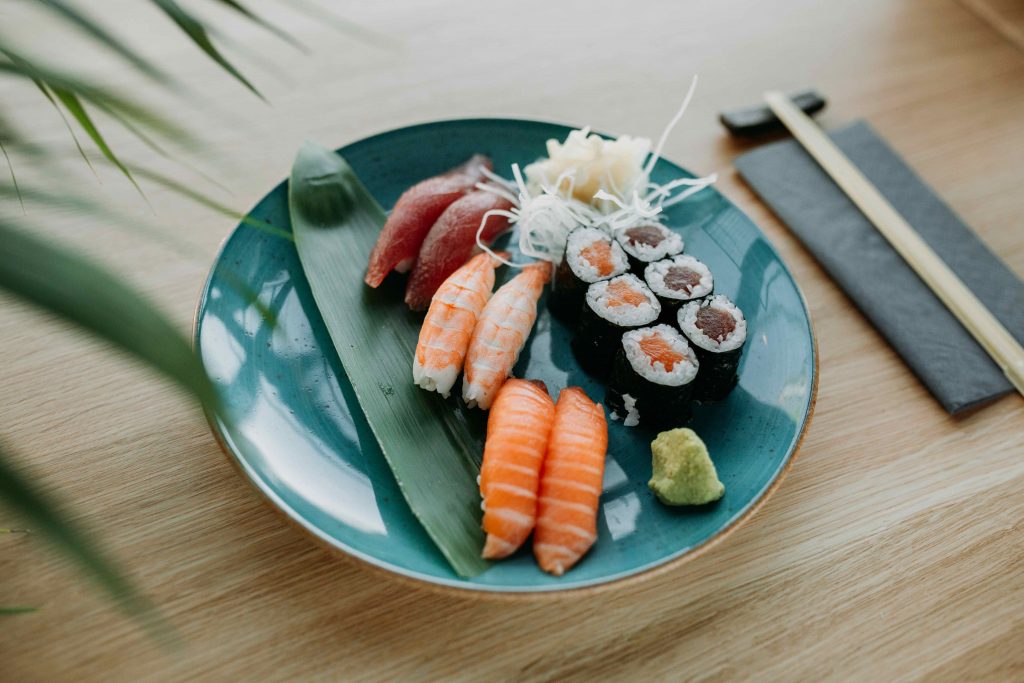
The current situation, due to the pandemic, has led to a boom in take-away food. Take-away has become particularly important due to the impossibility of being able to go to restaurants to eat. Asian food, especially sushi, is one of the most popular options among consumers and, for this reason, at Oriental Market Barcelona we offer a wide variety of sushi made with fresh ingredients and quality products. We know that the key to good sushi is undoubtedly the use of good raw materials, which is why we use fresh fish of the day and original products from Japan such as seaweed, soy or wasabi, which you can find both in our physical shops and on our website.
What varieties of sushi do we prepare?
Nigiri
Nigiri is the most popular and well-known type of sushi in Japanese cuisine. It consists of a piece of rice that is moulded with the hands into a cylindrical shape. A piece of fish or seafood is usually placed on top of this piece, and the bottom can be decorated with a seaweed leaf. At Oriental Market you can enjoy it with salmon, tuna, sea bream or prawns.
Uramaki
Uramaki is very similar to maki, but the difference between the two lies in the use of seaweed. The main characteristic of maki is that the seaweed is wrapped around the rice. However, in uramaki, the seaweed is placed on the inside, so the rice remains on the outside, visible. It is often garnished with sesame or other toppings. It is available with salmon, avocado and cream cheese.
Maki
Maki is another popular sushi option. The meaning of the word “maki” is rolled, so this variety stands out because the seaweed wraps around a roll of rice that is usually filled with vegetables or fish. The roll is usually cut into eight small portions that are meant to be eaten in one bite. You can choose from salmon, avocado, tuna, prawn, mango, cucumber or battered chicken.
However, although Oriental Market offers these types of sushi, there are other variaties with infinite possibilities that are prepared in Japan and that you should try if you are passionate about Asian cuisine like us.
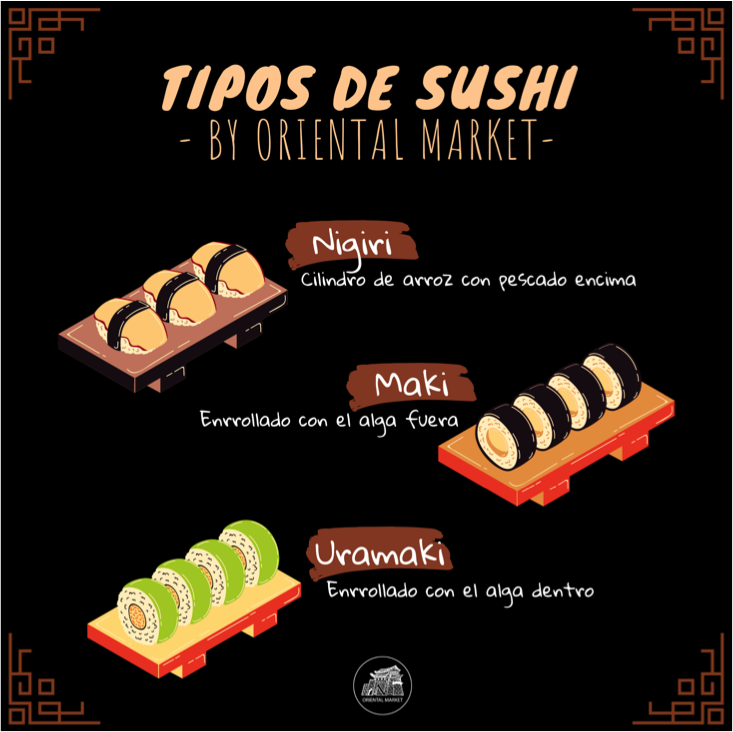
Fusion packs for the more indecisive
If you are one of those who find it hard to choose or you simply fancy trying different varieties and indulging your palate with flavours full of contrasts and sensations, these packs are for you. The fusion trays are made up of 10 to 20 pieces and combine the varieties described above. If you want to try the same type of sushi but with more than one flavour, we have a pack for you. If you want a bit of everything, both different types and different ingredients, we also have packs for you. At Oriental Market we have created these fusions to show that sometimes you can have it all. Besides, this option is perfect to enjoy alone or in company, it depends if you feel like sharing the moment in company.
About ordering
If you have decided to try our sushi creations, you can pick up your order at our shop in Barcelona (Carrer de Sicília, 212). Our opening hours are from 10am to 2pm and from 4pm to 8pm. You don’t need to place your order in advance, you can come directly to the shop to buy your sushi.
The number of sushi units per tray varies depending on the type of sushi. In the case of nigiri, for example, the tray comes with 6 pieces of salmon nigiri. The uramaki comes with 9 pieces, and the maki comes with no less than 20 pieces. On the other hand, we offer a total of 6 fusion packs with different combinations to suit all possible tastes and preferences. Of course, all the trays are made of plastic and are heat-sealed, perfect for not altering either the flavours or the aromas of the delicious morsels.
And you thought that was all? No, you didn’t. If you are not a sushi lover or you want to complement it with other types of dishes, at Oriental Market we also prepare other specialities of Japanese gastronomy. Try our udon, our yakisoba or Vietnamese rolls to finish your journey through the Asian continent from your sofa. Don’t miss it!
*You can find the prices and specific specifications of each of our products below:
[photos of the packs with the units and price].What is udon? Origins and recipes
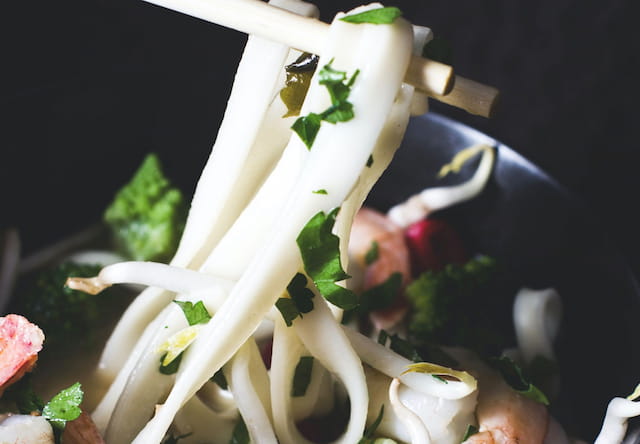
Along with their cousins yakisoba and ramen, Udon noodles are one of the most popular dishes in Japan. This dish is so fundamental in Japanese cuisine because of its many possibilities and combinations: they can be prepared cold, hot, with broth, without broth… In addition, their width and thickness give them a distinctive and soft texture that will give your palate a unique experience. In case you are still not very familiar with this dish, we tell you everything you need to know to become an expert of this Japanese gastronomic icon.
What is it?
The main characteristic of these noodles is their thickness. Udon are white, thick and have a somewhat sticky and elastic texture. They are made from salt water and wheat flour, and their manufacturing technique is, to say the least, peculiar. To knead them, you use your feet! But don’t panic, the dough is covered with plastic wrap.
In Japan, there are two main styles of Udon: Kanto, which comes from the Tokyo area, and Kansai, from the Osaka, Kyoto and Kobe areas. Those from the Osaka area differ from those from the capital in texture and colour: they are whiter and softer. However, beyond regional styles, there are also different types of noodles depending on the Udon dish being prepared. For example, Kishimen, which is a type of udon with a flatter shape compared to the original, or Inaniwa, which is much thinner.
Udon are said to be the noodles of a thousand and one recipes, and this is because they are a very versatile item with which you can play and create infinite versions. In its hot version, yakiudon is perhaps the best known dish outside Japan. It is prepared by frying noodles in soy sauce, just like yakisoba, and adding meat and vegetables. In its cold version, it is often used in salads with ingredients such as boiled egg, radish or cucumber. No matter what season of the year it is, there is always an option to enjoy a good Udon dish.
Where to buy them?
You can buy different types of Udon in our online shop or in our shops in Barcelona and Madrid.
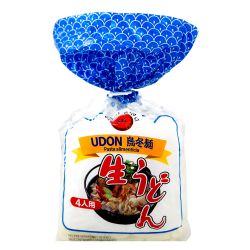
Udon Fresco (SK) 4 sobresx200g
3,03 €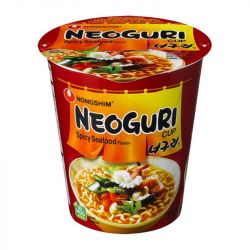
Tallarines Cup Neoguri (NONG SHIM) 62g
2,15 €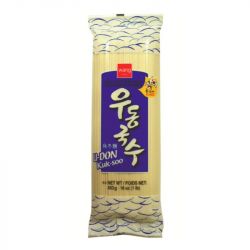
Tallarines Udon" (WANG). 453 g"
3,55 €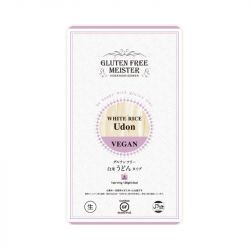
Tallarines udon sin gluten (KOBAYASHI) 128g
3,29 €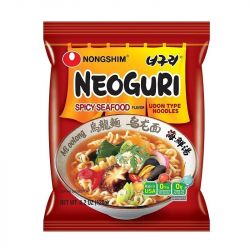
Tallarines neoguri udon marisco-pic (HOT) (NONGSHIM) 120g
1,95 €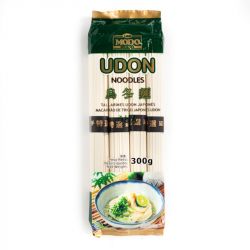
Tallarines Udon estilo japonés (MODO) 300g
2,19 €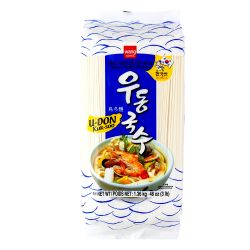
Tallarines Udon kuk-soo (WANG) 1,36kg
10,04 €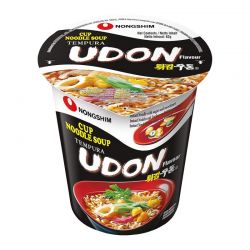
Noodles instantáneos Undon sabor tempura (NONGSHIM) 62g
2,09 €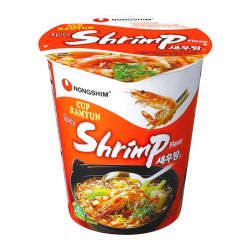
Tallarines (NONG SHIM).Udon.Sabor gambas 62 g
2,39 €
Origins
There is no real consensus as to when the Udon first came to Japan. Most accounts agree that the noodles originated in the Shinji Kagawa region. In the 1980s they began to gain popularity because the city used them to attract visitors. From then until today, Kawaga has been a place of pilgrimage and culinary tourism.
However, in its early days, Udon was a recipe only eaten by Buddhist monks in temples. It was not until the Edo era (1603-1868) that Udon noodles began to be consumed on a daily basis outside the temples. As with ramen, as a dish that can be eaten quickly, it became an option that people began to turn to when they wanted a quick bite to eat at the counter. It is for this reason that Japan is full of restaurants specialising in Udon and ramen, to the extent that you can find one on almost every street corner.
Recipes
Japanese recipes: How to make Miso Nikomi Udon
Ingredients:
450 cc dashi
2 tablespoons mirin
1 and 1/2 tablespoons red miso
1 tablespoon white miso
100 g udon
50 gr chicken
1 small piece of fried tofu
30 gr shimeji mushroom
30 g chives
1 egg
Noodles (Udon) with Teriyaki Sauce
Ingredients:
½ packet of Udon noodles, cooked and drained
¼ onion, thinly sliced
2 medium carrots, shredded julienned
2 cups cabbage, sliced thinly
1 cup Teriyaki sauce
1 tablespoon oil
½ teaspoon chilli flakes (or to taste)
1 cup bean sprouts (bean sprouts)
Salt and pepper for seasoning
Toasted sesame seeds to serve
Diced grilled chicken, shrimp or browned tofu cubes.
Curry: what it is, its origin and properties
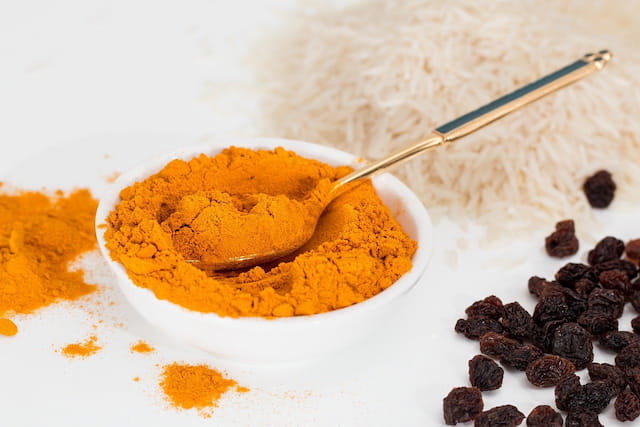
Known to be the soul of Indian cuisine, curry is an ingredient that is still a mystery to this day. Is it a dish? A spice blend? Or is it more of a sauce? Well, the answer to all these questions is yes. Curry is all of these things, but depending on the geographical area it is considered to be one thing or another. However, everywhere in the world there is one universal truth, and that is that curry is much more than just food. Its flavour evokes sensations and emotions that stimulate the senses and can take you on a journey through the taste buds.
What is curry?
The word curry comes from the Tamil “kari” meaning “sauce”. For an Indian, curry is any vegetable, meat or fish stew cooked in a creamy sauce and served with rice. In Europe, however, curry is understood as a mixture of various spices. The reason for this is that during the British colonisation period, the English were very fond of dishes cooked in these sauces, but when they saw the complexity of all the variations and ingredients, they decided to create an amalgam of standard spices and trade them under the name “curry”. Therefore, curry could be said to be the term created by the English to bring all the flavours and nuances together in one product.
What are the spices in curry?
There is no single way of making curry, the options are endless and depend on the taste of each person. As the saying goes… “there’s a recipe for every taste”. Even so, it is true that there are some basic spices that every good curry must include, even if to a greater or lesser extent. The most important ones are probably turmeric, cumin, cinnamon, coriander and nutmeg. Depending on whether you prefer it spicier, milder or more aromatic, you should also include others such as chillies, cardamom or saffron. It is also worth bearing in mind that there are different types of curry depending on the country where it is made:
Indian: this is the traditional one, a mixture of spices that varies according to the region.
Thai: it has some subtypes, the main ones being red, green and yellow. Also, it usually comes as a paste rather than a powder.
Japanese: it is usually found as a pressed paste, which is then dissolved in sauce.
Where to buy it?
In our online shop and in our shops in Barcelona and Madrid, you will find many varieties of curry, so that you can cook your own dishes or some dishes with this ingredient. In our shop you will also find complementary ingredients for this delicious dish, such as coconut milk.
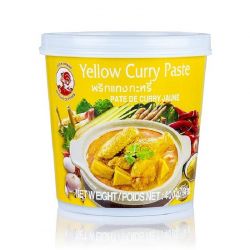
Pasta curry amarilla (COCK) 400g
3,59 €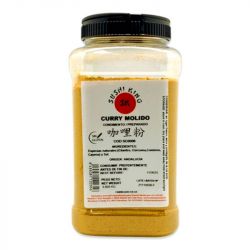
Polvo curry (SUSHI KING) 820g
9,89 €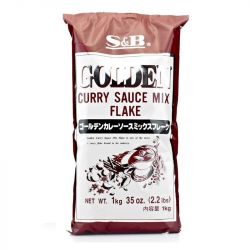
Curry japonés en copos (S&B) 1kg
16,95 €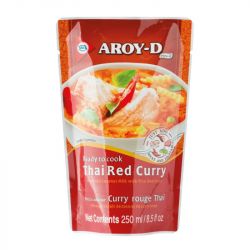
Salsa de curry rojo (AROY-D) 250ml
3,29 €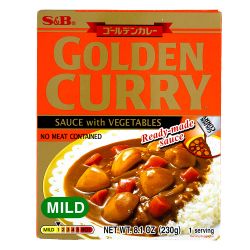
Salsa de curry poco picante con verduras (S&B). 230g
6,59 €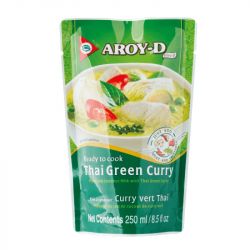
Salsa de curry verde (AROY-D) 250ml
3,29 €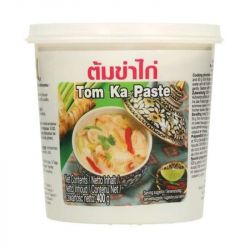
Pasta curry Tom Ka (LOBO) 400g
7,45 €
Origins and history
It is not possible to say with certainty when curry was created in India or when it came into use. According to researchers and archaeological excavations, the spice dates back to 2500 BC in the Mohenjo-Daro area of Pakistan. From that time onwards, curry flavours began to be used regularly and became the basis of Indian cuisine.
Over the years, Indian monks travelling along the Silk Road began to spread this spice blend throughout Asia and Europe. The spread throughout Asia was also influenced by the British, who introduced these ingredients to Japan and all the British colonies. The introduction of curries to so many different parts of the world led to their transformation and adaptation to local tastes. This is why there are now as many curries as there are people, because it is a condiment that is very easy to adapt to one’s own preferences.
Properties
As it contains so many spices that already have medicinal properties in themselves, the mixture of spices makes curry a food with great health-promoting properties. Undoubtedly, among all the spices, the most outstanding and the one with the most properties is turmeric.
Alzheimer’s
One of the components of turmeric is curcumin. In a 2006 US report, researchers stated that curcumin stimulates the immune system in a way that reduces cognitive decline and the chances of suffering from Alzheimer’s disease.
Cancer
Curcumin helps to destroy cancer cells associated with various types of cancer. In particular, this polyphenol can help fight glioblastomas, an aggressive form of cancer that originates in the brain.
Pain and inflammation
Turmeric is also a spice with positive effects on inflammation, pain and rheumatological diseases such as arthritis. Its anti-inflammatory effects help to reduce joint deterioration. Its qualities have even been compared to some popular medicines such as ibuprofen.
Antioxidant
Eating antioxidant-rich foods like curry helps prevent cell damage caused by a type of molecule called free radicals. Too many of these molecules in our bodies results in oxidative stress, a process of cell deterioration that is linked to heart disease, cancer and mental decline.
Heart
Two of the ingredients commonly added to curries are cardamom and sweet basil, both of which have vasodilatory properties. This means that they are very effective in reducing tension in the blood vessels by lowering blood pressure and minimising the chances of cardiovascular problems.
Umami: what it is, food and where to buy it
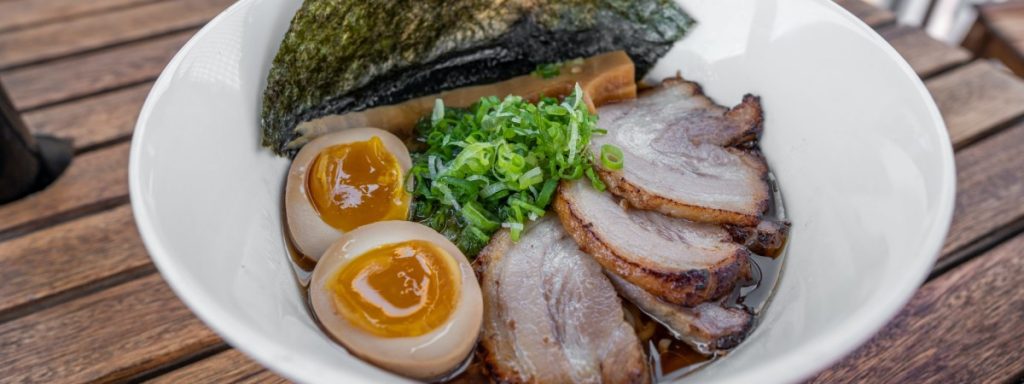
Sweet, salty, bitter, sour… Surely your taste buds have no trouble recognising and differentiating these flavours. But what if they told you that there was a fifth taste, and that it is present in many of the foods we eat? This powerful but unknown taste is umami. If you still don’t know what it is, what it tastes like or what foods you can find it in, don’t worry, we’ll tell you.
What is umami?
The word umami means “delicious” in Japanese. Although it is difficult to define, umami is a unique flavour, tasty but not salty. It can be perceived in a wider area of the tongue than the other four tastes, namely in the central part. When eaten, it produces a velvety sensation on the tongue and its intensity induces salivation.
Its origin dates back to the early 20th century, when Tokyo University scientist Kikunae Ikeda discovered that the cooking broth of kombu seaweed had a special taste, different from those traditionally known. Ikeda concluded that the amino acid glutamate (also known as glutamic acid or glutamate) was responsible for the unique but highly stimulating taste.
In order to be able to artificially obtain a condiment or ingredient that would provide the “umami” taste, the Japanese scientist synthesised large quantities of kombu seaweed broth. The result was a salt called monosodium glutamate, which was later marketed by the Ajinomoto company and catapulted him to international stardom. The reason? Because adding this seasoning to food enhances the flavour and aroma, which increases appetite by up to 40 per cent. This salt is often found in convenience foods, which is why it is so addictive, as if it is impossible to stop eating it.
What is monosodium glutamate?
Monosodium glutamate is a salt obtained by combining sodium with glutamic acid. It is an alternative that can be added to foods that do not have this flavour naturally, as it enhances their flavours. To identify it in different products, it is as simple as looking for the following names on the ingredients label: E-621, MSG, yeast extract, hydrolysed protein, glutamic acid, sodium caseinate or calcium caseinate.
Consuming this additive is safe for health but, be careful, in the right measure. The World Health Organisation has ruled that the consumption of glutamate is safe, always taking into account the authorised doses. As a component that is often added to processed foods, eating too much glutamate can have harmful effects. The main consequence is that the palate can become accustomed to such intense and unconventional flavours and reject the natural flavours of food. Therefore, although glutamate itself does not have a toxic effect, adding it to undesirable foods, such as ultra-processed foods, can have an influence on increasing its consumption.
Foods containing glutamate
As explained above, umami can be found in its artificial version in the form of monosodium glutamate. However, it is also possible to find this taste naturally in many foods that you probably eat every day. Some of the foods that naturally taste umami are Parmesan cheese, anchovies, ham or tomatoes.
Now you will understand why some of these ingredients are often added to some recipes. It is because of umami, which is able to enhance the flavours of other foods. The most representative example is broth, to which ingredients such as ham, some vegetables, mushrooms, meat or soy sauce are added to make it tastier and more appetising. So, even if you didn’t know what the concept of umami was, you were probably already incorporating it into your recipes unconsciously to enrich them and multiply their flavours.
Where to buy?
In our online shop and in our physical shops in the cities of Barcelona and Madrid, you can buy food with uramami flavour, and even an umami flavour enhancer to add to your dishes.
Wagyu, the best meat in the world
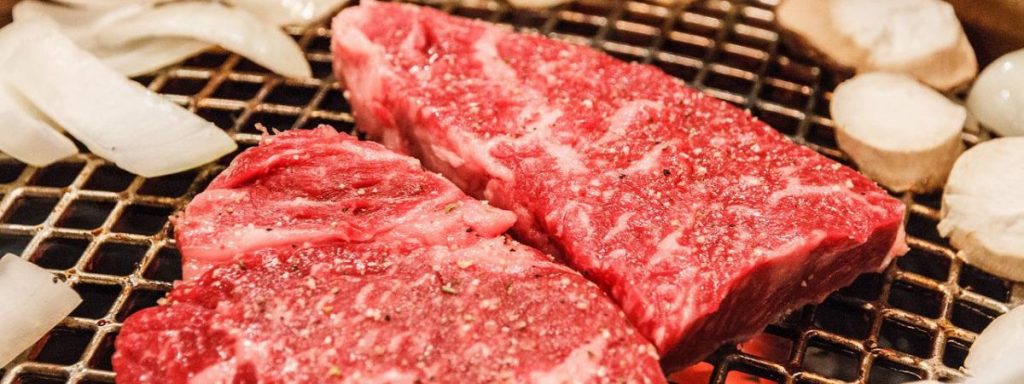
It may sound a little pretentious, but yes, Wagyu is the gourmet meat among meats. Wagyu is the most sophisticated and revered type of meat in Japanese cuisine due to its unique flavour, juiciness and textural characteristics that argue why it is one of the most sought-after meats on the market. And you may wonder… Is it really worth it? To help you find out, here are all the details and characteristics of this Japanese relic, considered by many to be “the best meat in the world”.
What is Wagyu beef?
Until relatively recently, very few people, except true lovers of meat and Japanese cuisine, were familiar with Wagyu. However, it was more common to know about kobe beef, a type of meat with a designation of origin and very strict quality standards. Due to the confusion that these two terms can generate, it is necessary to emphasise that these two meats are NOT the same.
Wagyu beef (pronounced as “guayu”) is a type of beef breed indigenous to Japan. Not all Japanese breeds are Wagyu, only four: Kuroge washu (Japanese black), Mukaku Washu (Japanese mocha), Nihon Tankakushu (Japanese horned) and Akage Washu (Japanese brown).
The error and confusion between the terms lies in referring to Wagyu beef as kobe. Actually, kobe is a designation of origin, i.e. a meat cannot be considered kobe until the animal has been slaughtered. Therefore, we can say that kobe is a type of Wagyu. However, not all Wagyu meat can be considered kobe because not all Wagyu meat meets the Japanese standards for kobe. Only some specific types of Wagyu are kobe.
And if you travel to Japan and want to try this animal delicacy, which places can’t you miss? Undoubtedly, the city of Kobe, where you can taste the best dishes with this ingredient in its already renowned Japanese cuisine restaurants. In addition, the Japanese government awards an official Wagyu seal every year to the best animals in the country.
Characteristics
What distinguishes this meat as one of the most exquisite and juicy in the world, also known as the ‘caviar of meats’, is its culinary versatility along with its flavour and tenderness. Wagyu beef is valued so highly over other beef breeds for its genetic ability to generate large amounts of marbling, also known as marbling, a fatty fibre found between the muscles. This fat is the defining characteristic of this meat because it is what gives it its melt-in-the-mouth texture. Moreover, the greater the amount of fat infiltrated into the meat, the more tender the meat is. Wagyu is also a meat rich in amino acids and unsaturated fats, which adds to its quality. In short: a tasty, high quality and protein-rich food, perfect to include as a treat in any diet.
However, cooking this meat requires knowledge and experience so as not to interfere with the properties of this indescribably delicate delicacy.
How to cook it?
As we have already underlined, fat is of particular importance in this type of meat. Therefore, it is the fat that will define the best technique for preparing it. The most common ways of preparation are as follows:
Grilled. This is apparently the easiest technique that anyone can use at any time. Of course, always respecting the point of the meat and avoiding too much cooking.
Double cooking. In this technique, the meat is first cooked at a suitable temperature to obtain the desired doneness and then marked on the griddle to brown it.
Barbecued or grilled. The best pieces to prepare are the sirloin and the tenderloin, as they are the most tender parts. If you want to be crowned with the result, leave it to cool for a few hours before cooking and add a few flakes of salt just after cooking. In Oriental Market we recommend this type of cooking and the use of traditional japanese barbecues that you can find in our shop.
Steak Tartar or Carpaccio. For the most avant-garde, Wagyu beef allows you to experiment in the kitchen and create recipes with it in the style of the well-known Steak Tartar, as well as in the form of carpaccio.
Tofu: what it is, benefits and recipes
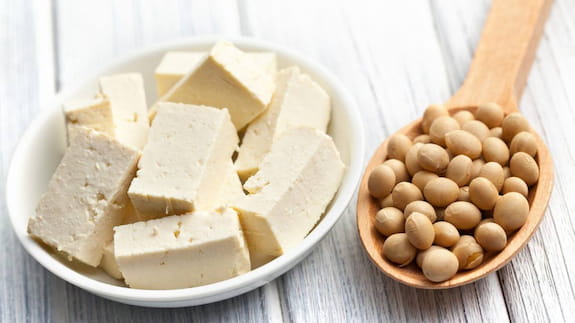
It is known to be the star ally of vegetarians. Taste is not its strong point, as on its own it does not taste of anything in particular. However, neutrality is the secret of its versatility in the kitchen. It is also one of the most widely consumed vegetable alternatives in the world due to its many properties. Still don’t know what it is? Well, we are talking about tofu, the vegetable protein par excellence.
Although it may seem like a modern, 21st century food, the truth is that tofu has been part of Asian cuisine for more than 2,000 years. It is an ingredient that can be used to create endless possibilities, from burgers, stews, stir-fries, sauces… even desserts! The problem is that its bland taste is not very appealing at first glance and it can sometimes be difficult to cook it so that it tastes like “something”. If you haven’t yet learned how to get the most out of this vegetable product, don’t worry, the battle is not yet lost. Starting today, you’ll learn how to prepare tofu to make mouth-wateringly tasty dishes.
What is tofu?
Tofu is a vegetable protein made from soya beans, water and a coagulant. Thanks to this last ingredient, tofu can acquire different textures, from firmer to softer. Moreover, its appearance and preparation is quite similar to that of cheese, which is why tofu is considered to be curdled soymilk.
To make tofu, soybeans are first soaked in water and then boiled, as is done with other legumes such as chickpeas. The soybeans are then crushed and all the water is removed, resulting in soya milk. The coagulant is then added to the milk. Depending on how much water is drained from the soybeans and how much coagulant is added, the tofu will have different firmnesses. If you are not familiar with the different textures and shapes of tofu, here is a quick mini-guide to the most common varieties.
Benefits of tofu
Tofu is a food rich in vegetable protein as it is derived from a legume, soya. As we have already mentioned, tofu is a basic ingredient in vegetarian or vegan diets as a source of protein, this is because the protein it provides is complete, i.e. it provides your body with the essential amino acids. However, tofu is also rich in calcium, fibre and iron. A normal serving covers 35% of the body’s iron and calcium needs. Because it has so many properties, tofu is a highly revered and health-promoting ingredient. Consuming tofu has a number of positive effects on the body, including the following:
Consuming vegetable protein such as tofu reduces the risk of some diseases such as diabetes or bone diseases due to its calcium.
It contains almost no fat, making it a healthy and light ingredient to add to any type of diet.
Its high levels of calcium reduce the risk of kidney stones. In addition, its vitamins and minerals (iron, phosphorus and potassium) prevent diseases such as anaemia, promote memory function, and reduce hypertension and fluid retention.
It is much better digested compared to other animal proteins, so it is a good choice for people with digestive problems or for those who do not like to suffer from heavy digestions.
Because it is low in fat and contains many vitamins, it helps to reduce cholesterol and also helps against heart disease.
Tofu contains phytoestrogens, specifically isoflavones, which are similar in structure to oestrogens. It is therefore recommended to consume tofu during the menopause to help hormonal balance as there is a great hormonal imbalance that takes place during this stage.
Buy tofu: on its own and in cooked dishes
In our online shop, or in our Barcelona shop, you will find many products made with tofu, either on its own or cooked or made with this ingredient. These are some of them:
Recipes with tofu
Tofu teryaki
Ingredients
– 1/4 cup soy sauce
– 1 teaspoon grated ginger
– 1 teaspoon grated garlic
– 1 teaspoon tahini (peanut butter can be substituted for the tahini)
– 3 tablespoons piloncillo honey (you can use brown sugar, agave, maple or sweetener of choice)
– 1 block of firm tofu (about 315 g).
How to cook tasty tofu
Find out how to cook tofu and get a very tasty flavour in your vegetarian dish.
What are wagashi? Origin, history and how to serve them
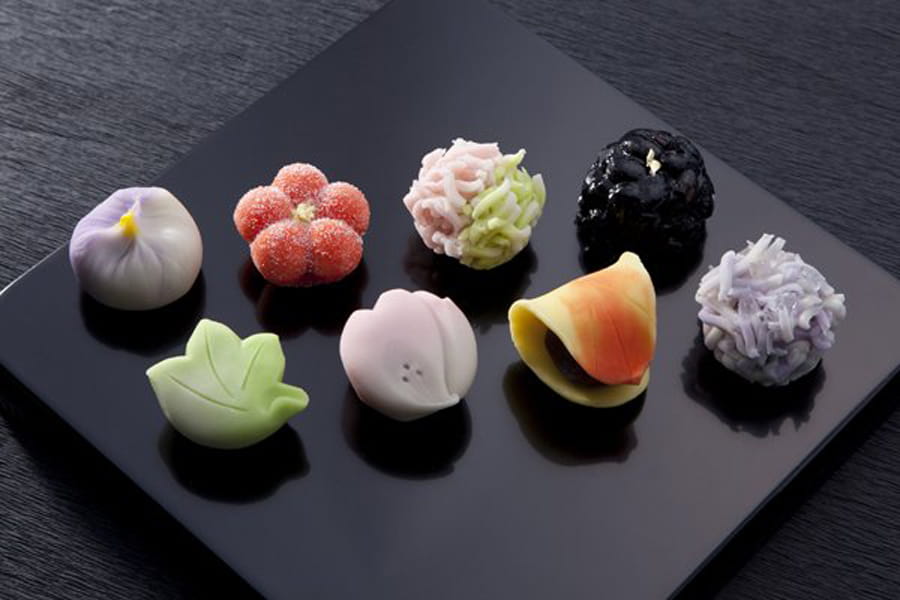
Japanese confectionery culture is characterised by its ability to stimulate all five senses. The traditional pastries are so elegant and refined that they look more like miniature works of art than sweets. The wagashi encompasses all those traditional cakes that used to accompany tea ceremonies. Today we invite you to discover Japan’s sweet tooth with these little morsels, whose taste and design will blow your mind.
What are wagashi?
Wagashi are traditional Japanese sweets that are usually served as an accompaniment to tea, as their sweetness combines and balances the bitter taste of green tea. They are usually made with natural ingredients such as azuki beans. As these sweets were created expressly for the tea ceremony, their aesthetics became one of the most important points, which is why they look so neat.
What stands out about these cakes is that they stimulate all five senses equally. Their nature-inspired designs stimulate the vision. In spring, for example, wagashi are made to represent the cherry blossom. They also stimulate the sense of hearing, as each wagashi has a name that refers to an object or poem. As for the sense of taste, wagashi should not be too sweet. As we have already mentioned, the combination of the sweetness of these sweets with the bitterness of matcha or green tea creates the perfect balance where the flavours enhance and complement each other. Finally, the sense of touch is stimulated by the soft but varied texture of the wagashi.
Compared to Western desserts, which are characterised by the addition of a lot of butter and fats, traditional wagashi use very little oil or dairy products. The ingredients are based on grains such as wheat and rice, red beans and sugar.
Origin and history of wagashi
The history of wagashi and the tea ceremony are closely related. However, there is no consensus on the exact date of their origins. Some believe they date back to the Yayoi period (300 BC – 300 AD), where sweets made from the natural sugar of fruits and nuts were consumed. It wasn’t until a few years later that China began to influence Japan’s food culture and the first snacks were developed that are still available today: dango and mochi, which are characteristically made from rice.
However, the key element that revolutionised the culinary art of Japanese confectionery was sugar. Sugar was considered a luxury ingredient, to which very few had access due to its high price, and was mainly used in medicine. Thanks to Portuguese traders, sugar began to be introduced into Japanese cuisine. However, there is controversy about this, as some argue that it was the Chinese who introduced sugar to Japan. Once this ingredient filled the markets, it was incorporated more regularly into dishes. And that is really how the first sweets were born.
The true splendour of wagashi began in the period known as Edo (1603-1867). Processed white sugar began to be marketed in the capital, Edo, and also in Kyoto. These pastries, which first belonged to the upper classes, became more popular when they were introduced into the tea ceremony as an (almost) obligatory element.
How to serve them
As mentioned above, wagashi are closely associated with the tea ceremony. But this is not the only occasion when you can eat these delicious creations. You can also eat them as a dessert after a meal, as an afternoon snack, as a snack, etc. There is no longer a strict tie to wagashi as an accompaniment to green tea, in fact, you can accompany it with tea as well as with other types of beverages such as coffee.
In addition, wagashi are also an excellent gift idea. Their aesthetics make them so beautiful to look at, that they work perfectly as a gift for engagements such as weddings. The gift culture is very important for the Japanese, as it is a way of showing appreciation and enhancing social ties. Therefore, wagashi, being so appreciated in the country’s pastry culture, are a great way to give someone a gift on a special day.
Shiso in Japanese cuisine
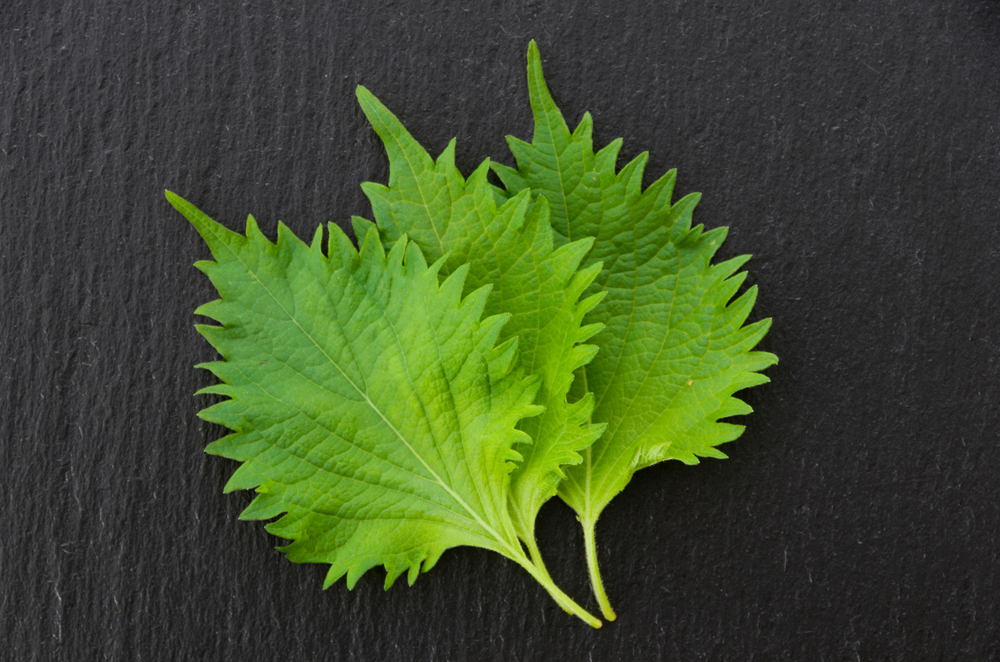
Also known as Japanese basil, shiso has been used for years to flavour Asian cuisine. The infinite variety of flavours and nuances offered by its leaves will allow you to give another life to your dishes, whether as a garnish, ingredient or seasoning. Furthermore, shiso is not only popular in the kitchen, but also in the field of traditional medicine, where it is highly revered for its great antihistamine properties.
What is shiso
As already mentioned, shiso (perilla frutescens) is an aromatic plant. In the West, it is often called Japanese basil or Chinese basil. There are different types of shiso, but the most common are red and green. Red, known as akajiso, is mostly used as a food colouring, especially to give umeboshi its characteristic dark, bright red colour. It is not usually eaten raw, but its sprouts are used to accompany sushi and give it a spicy and tangy flavour.
Green shiso is more commonly used in cooking than red shiso, either whole leaves or sprouts. Its flavour, which is quite intense, is a mixture of mint and aniseed. As well as being used for sushi or sashimi, it can also be found as a complement to other dishes such as salads, meat, pasta or fish stews, or to prepare infusions. Its seeds are often cooked with chillies to make a spicy preparation that serves as a condiment.
In traditional medicine, the plant is considered sacred by Asians for its anti-allergic, antimicrobial, antioxidant and anti-inflammatory properties, making it a widely used resource on the continent. Infusions are usually made from the dried leaves of the plant and a little honey or lemon is added to soften the flavour. It is also possible to prepare an oil rich in omega 3,6 and 9 from its seeds, which is used to treat dermatological problems, such as irritated skin.
Popular recipes with shiso
In Japanese cuisine, green shiso leaves are often incorporated into sushi dishes, especially sashimi, as a garnish and complement. In addition, it can also be used as a substitute for nori seaweed in other sushi varieties, such as onigiri.
Another common way of consuming nori leaves is in batter and tempura frying. However, they are most commonly used as a seasoning for soups, stews, stir-fries… For example, shiso can be chopped and added as a final seasoning to dishes as we would do with other aromatic plants such as parsley. However, always add it at the end of cooking, as the heat spoils its colour and texture.
Thanks to its refreshing power, it is perfect for contrasting strong flavours such as vinegar, which is why it is used in pickles and fermented foods such as kimchi or sauerkraut. Similarly, it balances the fat in oily fish or red meat, and its umami touch makes it the perfect partner for mushrooms, cheeses or nuts. It can also be incorporated into dishes that are not too complex to enhance their flavour, such as tuna tartare or grilled salmon,
Use in Japanese and other Asian cuisines
As you have seen in the previous paragraph, shiso has a wide variety of uses in cooking, but one feature that distinguishes it from other aromatic herbs such as basil is that all parts of the plant can be used: leaves, stem, seeds and shoots. Each of these has its own role and knowing how to use them can be a way to prepare creative recipes. Another possible use of shiso is to use it in Western dishes to achieve a very interesting fusion effect. In this case, the crux of the matter is to experiment and try, especially with those traditional dishes that can lead to a totally unexpected result.
Azuki beans: from Japan to your table
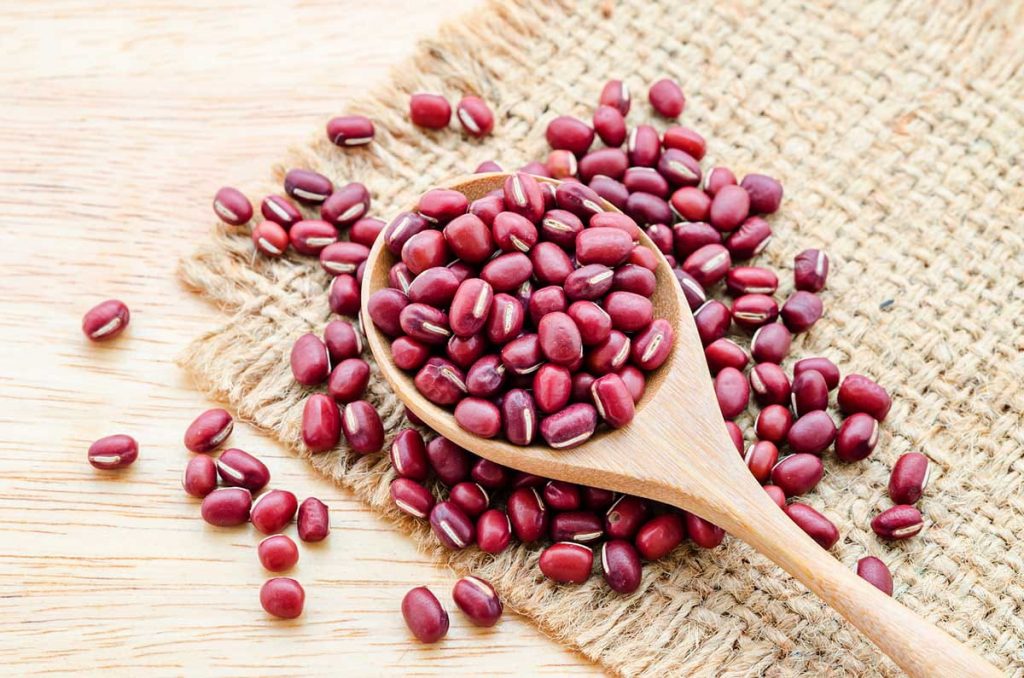
A healthy lifestyle and a balanced diet is already a trend. Food is one of the sectors that does not escape from fashions and, for this reason, some foods are becoming the claim of the diets of the moment. Avocado, quinoa, chia or turmeric are some of the ingredients that have become the kings of healthy eating, but they are not the only ones. But they are not the only ones. Do you want to know what the latest addition is? Azuki beans, a delicious, versatile and healthy food of Japanese origin.
About 10 years ago, azuki beans were a complete unknown, they could hardly be found in grocery shops or conventional supermarket chains. Today, however, azuki has become a revolution among legumes. Their multiple health benefits and nutritional properties have come to be regarded as a source of superpowers for the body.
What are azuki beans?
Azuki beans are small beans similar to red beans, although it is possible to find them in other colours as well. They are often used in paste form for the preparation of various recipes and even desserts. Thus, it is a very versatile ingredient in the kitchen, as it can be used in both sweet and savoury dishes. Its texture is very soft, so it is easily adaptable to thousands of recipes.
In Asia, azuki is extremely popular and widely cultivated, especially in eastern Asia and the Himalayan region. However, it is nowadays possible to find them in health food shops, herbalists or supermarkets, as they have become very popular in recent years.
Evolution and history of azuki beans in Asian cuisine
Azuki beans are not a new product. In Asia, they have been cultivated since 1000 BC. In the early days, many elders believed that azuki beans were a good luck charm because of their red colour, which is why they were often used in many events and ceremonies in Japan, China and Korea. They were also used as medicine, as the Japanese already valued their nutritional and medicinal properties at that time.
Health benefits of azuki beans
Keep in mind that no food is a miracle food, nor will it make you change physically or physiologically by consuming it. A healthy and varied diet, which includes this food, is what will contribute to an improved state of health and help prevent many illnesses. These are some of the benefits of this legume:
Improves intestinal health. Azuki is rich in soluble fibre and resistant starch, which improves transit and digestion.
They reduce the risk of type 2 diabetes. The high fibre content of these beans helps to improve insulin sensitivity and reduce blood sugar spikes after eating.
They help regulate weight. This legume has the ability to increase the expression of genes that reduce hunger and increase the feeling of satiety. Azuki are rich in protein and fibre, which also helps to reduce appetite.
Good for cardiovascular health. Consumption of pulses in general is associated with lower cholesterol levels and a reduced risk of heart disease.
Popular recipes
As mentioned above, azuki can be eaten in both sweet and savoury dishes. That’s why we leave you with a choice of each so you know how to cook them in each case. Here they go:
Anko
200 grams of azuki
75 grams of white sugar
50 grams of brown sugar
A pinch of salt
Preparation
Soak the beans in water for at least ten hours. After soaking, drain the azuki beans and put them in a pot with water, three times the content of the azuki beans, cover and place on the heat. Once it comes to the boil, reduce the heat to the minimum and cook, uncovered, for 45-60 minutes, until tender.
Once cooked, drain the red beans well and return them to the pan over a medium-low heat, add the sugar and allow it to melt, stirring occasionally. Continue cooking without bubbling too much to evaporate the water. Add the pinch of salt. The dough should be more or less dry so that you can use it to fill cakes and pastries, such as dorayakis, for example.
Azuki stew
500 grams of azuki
200 g brown rice
300 grams of pumpkin
1 onion
1 tomato
4 garlic
½ teaspoon dried thyme
1 teaspoon of paprika de la Vera
½ teaspoon turmeric powder
1 pinch of pepper
Salt to taste
4 tablespoons tamari sauce (or soy sauce)
olive oil
A few leaves of fresh coriander (optional)
Preparation
Before preparing this recipe, the azuki must be soaked for at least 8 hours. A good option is to soak them the night before.
Place the azuki, onion, garlic and tomato in a large pot. Cover everything with water (about a litre and a half) and put it on the heat. Add all the spices except salt. Bring to the boil. Once it starts to boil, lower the heat, put the lid on and leave it to cook for 1 hour. Meanwhile, cook the brown rice for 40 minutes in plenty of salted water. Set aside.
Once the azukis have been cooking for an hour, remove the onion, garlic and tomato and mash well with a little of the cooking water. Add what you have just mashed to the pot. Add the diced pumpkin, salt and tamari (do not overdo it with the salt because tamari is salty). Cook for a further 15 minutes and turn off the heat.
Serve in a deep dish with a couple of spoonfuls of boiled brown rice and some fresh coriander.

